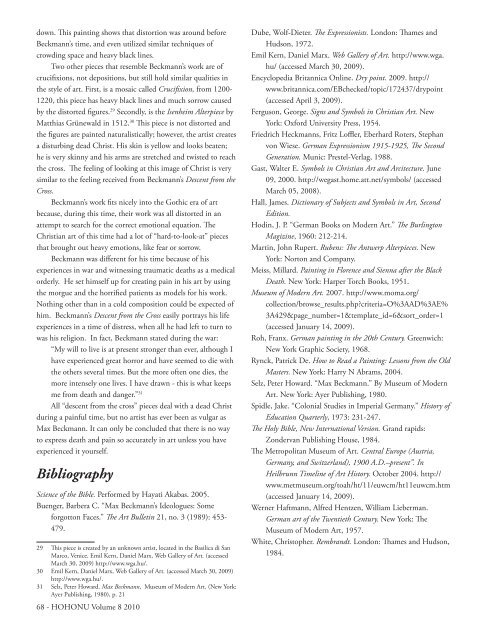A JOURNAL OF ACADEMIC WRITING VOLUME 8
A JOURNAL OF ACADEMIC WRITING VOLUME 8
A JOURNAL OF ACADEMIC WRITING VOLUME 8
You also want an ePaper? Increase the reach of your titles
YUMPU automatically turns print PDFs into web optimized ePapers that Google loves.
down. This painting shows that distortion was around before<br />
Beckmann’s time, and even utilized similar techniques of<br />
crowding space and heavy black lines.<br />
Two other pieces that resemble Beckmann’s work are of<br />
crucifixions, not depositions, but still hold similar qualities in<br />
the style of art. First, is a mosaic called Crucifixion, from 1200-<br />
1220, this piece has heavy black lines and much sorrow caused<br />
by the distorted figures. 29 Secondly, is the Isenheim Alterpiece by<br />
Matthias Grünewald in 1512. 30 This piece is not distorted and<br />
the figures are painted naturalistically; however, the artist creates<br />
a disturbing dead Christ. His skin is yellow and looks beaten;<br />
he is very skinny and his arms are stretched and twisted to reach<br />
the cross. The feeling of looking at this image of Christ is very<br />
similar to the feeling received from Beckmann’s Descent from the<br />
Cross.<br />
Beckmann’s work fits nicely into the Gothic era of art<br />
because, during this time, their work was all distorted in an<br />
attempt to search for the correct emotional equation. The<br />
Christian art of this time had a lot of “hard-to-look-at” pieces<br />
that brought out heavy emotions, like fear or sorrow.<br />
Beckmann was different for his time because of his<br />
experiences in war and witnessing traumatic deaths as a medical<br />
orderly. He set himself up for creating pain in his art by using<br />
the morgue and the horrified patients as models for his work.<br />
Nothing other than in a cold composition could be expected of<br />
him. Beckmann’s Descent from the Cross easily portrays his life<br />
experiences in a time of distress, when all he had left to turn to<br />
was his religion. In fact, Beckmann stated during the war:<br />
“My will to live is at present stronger than ever, although I<br />
have experienced great horror and have seemed to die with<br />
the others several times. But the more often one dies, the<br />
more intensely one lives. I have drawn - this is what keeps<br />
me from death and danger.” 31<br />
All “descent from the cross” pieces deal with a dead Christ<br />
during a painful time, but no artist has ever been as vulgar as<br />
Max Beckmann. It can only be concluded that there is no way<br />
to express death and pain so accurately in art unless you have<br />
experienced it yourself.<br />
Bibliography<br />
Science of the Bible. Performed by Hayati Akabas. 2005.<br />
Buenger, Barbera C. “Max Beckmann’s Ideologues: Some<br />
forgotton Faces.” The Art Bulletin 21, no. 3 (1989): 453-<br />
479.<br />
29 This piece is created by an unknown artist, located in the Basilica di San<br />
Marco, Venice. Emil Kern, Daniel Marx, Web Gallery of Art. (accessed<br />
March 30, 2009) http://www.wga.hu/.<br />
30 Emil Kern, Daniel Marx, Web Gallery of Art. (accessed March 30, 2009)<br />
http://www.wga.hu/.<br />
31 Selz, Peter Howard. Max Beckmann, Museum of Modern Art. (New York:<br />
Ayer Publishing, 1980), p. 21<br />
68 - HOHONU Volume 8 2010<br />
Dube, Wolf-Dieter. The Expressionists. London: Thames and<br />
Hudson, 1972.<br />
Emil Kern, Daniel Marx. Web Gallery of Art. http://www.wga.<br />
hu/ (accessed March 30, 2009).<br />
Encyclopedia Britannica Online. Dry point. 2009. http://<br />
www.britannica.com/EBchecked/topic/172437/drypoint<br />
(accessed April 3, 2009).<br />
Ferguson, George. Signs and Symbols in Christian Art. New<br />
York: Oxford University Press, 1954.<br />
Friedrich Heckmanns, Fritz Loffler, Eberhard Roters, Stephan<br />
von Wiese. German Expressionism 1915-1925, The Second<br />
Generation. Munic: Prestel-Verlag, 1988.<br />
Gast, Walter E. Symbols in Christian Art and Arcitecture. June<br />
09, 2000. http://wegast.home.att.net/symbols/ (accessed<br />
March 05, 2008).<br />
Hall, James. Dictionary of Subjects and Symbols in Art, Second<br />
Edition.<br />
Hodin, J. P. “German Books on Modern Art.” The Burlington<br />
Magizine, 1960: 212-214.<br />
Martin, John Rupert. Rubens: The Antwerp Alterpieces. New<br />
York: Norton and Company.<br />
Meiss, Millard. Painting in Florence and Sienna after the Black<br />
Death. New York: Harper Torch Books, 1951.<br />
Museum of Modern Art. 2007. http://www.moma.org/<br />
collection/browse_results.php?criteria=O%3AAD%3AE%<br />
3A429&page_number=1&template_id=6&sort_order=1<br />
(accessed January 14, 2009).<br />
Roh, Franx. German painting in the 20th Century. Greenwich:<br />
New York Graphic Society, 1968.<br />
Rynck, Patrick De. How to Read a Painting: Lessons from the Old<br />
Masters. New York: Harry N Abrams, 2004.<br />
Selz, Peter Howard. “Max Beckmann.” By Museum of Modern<br />
Art. New York: Ayer Publishing, 1980.<br />
Spidle, Jake. “Colonial Studies in Imperial Germany.” History of<br />
Education Quarterly, 1973: 231-247.<br />
The Holy Bible, New International Version. Grand rapids:<br />
Zondervan Publishing House, 1984.<br />
The Metropolitan Museum of Art. Central Europe (Austria,<br />
Germany, and Switzerland), 1900 A.D.–present”. In<br />
Heilbrunn Timeline of Art History. October 2004. http://<br />
www.metmuseum.org/toah/ht/11/euwcm/ht11euwcm.htm<br />
(accessed January 14, 2009).<br />
Werner Haftmann, Alfred Hentzen, William Lieberman.<br />
German art of the Twentieth Century. New York: The<br />
Museum of Modern Art, 1957.<br />
White, Christopher. Rembrandt. London: Thames and Hudson,<br />
1984.
















